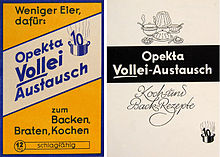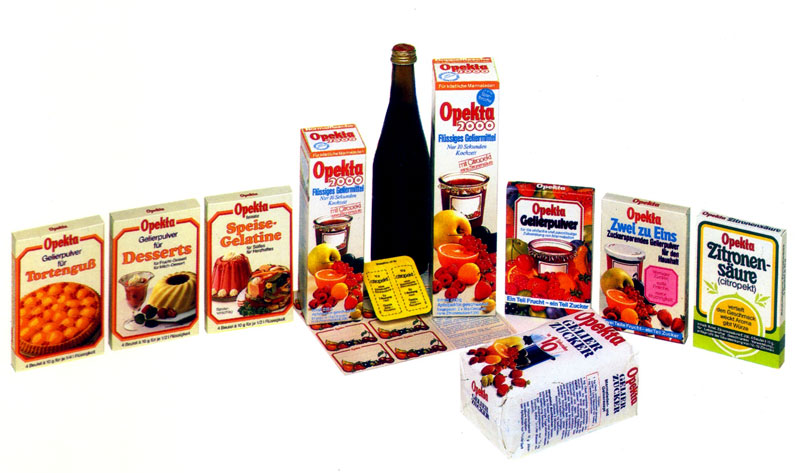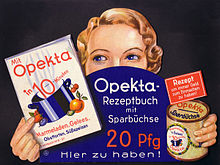Opekta (brand name)
In 1928, Opekta was the first German brand for pectin and pectin-containing products for the production of jams and fruit jellies - as the first manufacturer in pack sizes for private households.
Opekta is a portmanteau of " O bst pect in from the A apples" . Opekta quickly became the generic name for such gelling agents as a preparation aid for self-made spreads made from fruit . It was manufactured in a company of the same name with headquarters in Cologne with branches in Amsterdam , Vienna , Prague and Basel , which served as wholesalers and retailers. From 1982 the family business was sold several times. All Opekta products with the name Opekta have disappeared from the market since the mid-1990s.
History of the brand
The Opekta brand was first registered in the trademark register at the German Patent and Trademark Office on May 3, 1928 by Opekta Gesellschaft mbH in Cologne, represented by company founders Robert Feix and Richard Fackeldey . The last time she was presented by Dr. Oetker on July 5, 1999.
Protected product areas: Medicines, chemical products for medical and hygienic purposes, pharmaceutical drugs and preparations, plasters, bandages, animal and herbicides, disinfectants, preservatives for food, wines, spirits, fruit wines, sparkling wines, essences and extracts containing alcohol, mineral water, non-alcoholic beverages , non-alcoholic essences and extracts, bath salts, cocoa, chocolate , sugar confectionery , baked goods and confectionery, yeast, baking powder, dietetic foodstuffs, malt, animal feed, ice cream, meat and fish products , meat extracts, preserves, vegetables, fruit, fruit juices, jellies, coffee , Coffee substitutes, tea, sugar, syrup, honey, flour, pasta, spices, sauces, mustard, table salt, jam; Preservatives for food; Dietetic nutrients based on vitamins, trace elements and minerals; Dietetic food based on carbohydrates; non-alcoholic liquid fruit products of all kinds.
Products
The best known and most popular product from Opekta was the product Opekta liquid . It was only sold in summer and late summer when there was a lot of fruit. It was a brown liquid, was bottled in brown or green bottles and had a shelf life of a maximum of two years, although it does not get bad, it just loses the desired effect more and more.
Opekta liquid is made from pectin and is obtained from apple pomace . Among other things, it is said to have a healing effect on the digestive tract.
Pectin is a natural component in almost all fruits, but especially in unripe apples and lemons . The more unripe the fruit, the more pectin they contain and the firmer the consistency. As the fruit ripens, the pectin breaks down more and more, and the firmness decreases. When canning, pectin with sugar (nowadays gelling sugar or gelling powder) is added to the fruit. After being briefly heated during preparation, the pectin forms a firm gel together with the fruit-sugar-acid mixture as it cools .
In 1937 the normal bottle cost 86 pfennigs (enough for an average of eight pounds of jam), the so-called double bottle cost 1.53 Reichsmarks .
Other well-known products from the house were among others
- Opekta dry
- Opekta 2000
- Opekta edible gelatine
- Opekta gelling powder for cake glaze
- Opekta two to one
- Opekta preserving sugar
- Opekta gelling powder for desserts
- Opekta Gelavit (sugar-saving gelling agent)
- Opekta citric acid (Citropekt)
- Opekta whole egg exchange and others
Under the management of the Schwartauer Werke , the fresh fruit jam Opekta came onto the market on August 1, 1993 , in cherries, strawberries and raspberries (250 g jar).
Books and recipe books
Furthermore, new and unusual recipes for jams were developed again and again in the in-house test kitchen. These were then published by the Opekta-Gesellschaft in books, advertising brochures or recipe booklets with ever increasing circulation. The best-known series of issues was With Opekta in 10 minutes and was published since 1929. The last revised 39th edition from 1989 indicates in the imprint to a total edition of 56,660,000 copies.
Other well-known recipe books include:
- The new Opekta recipe book (stapling)
- Opekta recipes, jams, jellies, fruit tarts, desserts (32 pages, stapled)
- The world of jam - The large jam cookbook by Opekta (spiral binding)
- Use Opekta to make jams, jellies, fruit tarts, desserts, vanilla and fruit ice cream in 10 minutes. (Stapling)
All these and other Opekta books are only available in antiquarian form.
advertising
Opekta advertising did not only appear in books and magazines. There were also tin signs and later television advertisements.
Initially, the advertisements were mostly very colorful and lovingly drawn illustrations with lots of fruit and mostly with at least one blue saucepan. Later the number '10' followed in the steaming saucepan (which always stood for the fast cooking time). The children who appear in many drawings should not only show the popularity of the end product - the jam - with children, but also point out how easy it is to use the product.
From the 1950s onwards, the drawings gradually became fewer and product photos were used.
The company's own colors red and blue, which also featured in the logo, were particularly noticeable from the start.
Opekta advertisement still in Sütterlin script in the early 1930s
Jam vs. jam
Before the "Jam Ordinance" of October 26, 1982 of the European Community , preparations made from a wide variety of fruits were called jams. That is why until 1982 you only ever found the terms “jams” and “jellies” in Opekta advertising. However, the Swiss Opekta is an exception.







